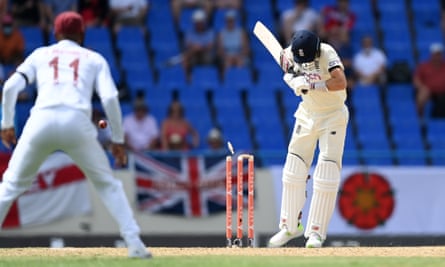For the first time in over two years England’s army of travelling supporters took over a Test ground away from home, their St George’s flags draped all over the Sir Vivian Richards Stadium like towels on the beach well before a ball had been bowled.
By the close, as a woozy sun began its final descent and thoughts turned to Antigua’s evening attractions, they had witnessed an absorbing first day of this three-match series against West Indies. It featured a sparkling unbeaten 109 from one of their long-time favourites, Jonny Bairstow, and saw England reach 268 for six. Equally there was a reminder that the post-Ashes “red-ball reset” may not be instant.
Things had certainly begun in all-too familiar fashion after Joe Root won the toss on a beige pitch with barely a blade of grass to be seen, four wickets falling inside the first 16 overs as West Indies flew out of the traps. Kemar Roach led the charge in typically waspish fashion, ruining the debut of Alex Lees, lbw for four, and bowling Root on 13 without a shot offered when he got one to swing in, nip further and kiss the off bail.
But from 48 for four resistance came from the engine room of a side that features six changes from the end of that sorry Australian campaign. First came a stand of 67 between Bairstow and Ben Stokes, the all-rounder personally chiselling out 36 either side of lunch, before Ben Foakes combined with the Yorkshireman for a 99-run partnership. Chris Woakes then held firm to walk off at the end 24 not out.
This was a typically bristling, characterful innings from Bairstow, continuing the form witnessed during scores of 131 and 41 in Sydney and adding to the sense that a talent on the brink of being lost to white-ball specialism is being reborn. Determinedly moving to his half-century from 127 balls, Bairstow then spent the evening session wielding his bat like a blacksmith’s hammer every time the West Indies attack dropped short.

There was one heart in mouth moment for the England supporters – if not the man himself – when Bairstow successfully overturned a caught behind off-spinner Veerasammy Permaul on 59. But come the 78th over they broke out into rum-fuelled song when the 32-year-old swept the shoddy off-breaks of Kraigg Brathwaite for Test century number eight and his latest look to the heavens above.
That England didn’t fold also owed much to Stokes, even if he battled for rhythm and his eventual demise – bowled by Jayden Seales off the inside edge – frustrated. So, too, Foakes, with the wicketkeeping gloves having returned to a cricketer who wants to show his game is more than just silken work behind the stumps.
Quick GuideNew law will ban players using saliva on the ball
Show
Using saliva on the ball will be banned and considered tampering under a new set of laws announced by the MCC.
After the sport resumed following the outbreak of Covid-19, the ban was a playing condition in most forms of the game. Research by the sport's lawmakers found this "had little or no impact on the amount of swing the bowlers were getting", with players using sweat to polish the ball, which was equally effective.
The MCC said the new law, which will come into force from October, "also removes any grey areas of fielders eating sugary sweets to alter their saliva to apply to the ball," with its use treated the same way as "any other unfair methods of changing the condition of the ball".
In other changes announced on Tuesday, a new batter coming to the crease will face the next delivery regardless of whether the previous pair had crossed while the ball was in the air before being caught. This follows a trial used by the England and Wales Cricket Board during the Hundred.
The law around judging a wide has been amended, given batters are now moving laterally around the crease more before the ball is bowled. There are several changes to the 'dead ball law', the most significant of which if either side is disadvantaged by a person, such as a pitch invader, an animal or other object within the field of play which has a material impact on the game.
MCC laws manager Fraser Stewart said: "Since the publication of the 2017 Code of the Laws of Cricket, the game has changed in numerous ways. The second edition of that code, published in 2019, was mostly clarification and minor amendments, but the 2022 Code makes some rather bigger changes, from the way we talk about cricket to the way it's played.
"It is important that we announce these changes now as part of the club's global commitment to the game, giving officials from all over the world the chance to learn under the new code ahead of the laws coming into force in October." PA Media
Shirt sleeves buttoned down and with a smear of zinc cream across his bottom lip, the 29-year-old produced a gem of his own first-up, caressing eight fours in an 87-ball 42 that surpassed the best of Jos Buttler’s last 15 Test innings before the axe fell.
A typically fine piece of bowling from Jason Holder eventually removed Foakes after tea, the former skipper jagging one in for a plumb lbw and finishing the day with standout figures of two for 15 from 16 overs. Seales, the young Trinidadian, also struck twice to show his promise but as the day wore on, he and the at-times unfortunate Alzarri Joseph (none for 69), began to look leggy. Roach’s best work came when the ball was at its hardest, enjoying lavish swing that should encourage England.
This proved lethal first thing, with the only misstep from the hosts coming when the two teams lined up and the original upbeat version of Rally ’Round the West Indies, David Rudder’s seminal calypso, blared out of the stadium’s speakers, rather than its slow and stirring equivalent that serves as the cricketing anthem of this region.
Perhaps this extra soca vibe put a spring in the steps of a West Indies team that has Holder slated at No 6 to allow four quicks plus a spinner; perhaps it further disorientated a visiting side that during the seven weeks between Test matches has lost its director of cricket, head coach, his assistant and seen eight players dropped, including two all-time greats in Jimmy Anderson and Stuart Broad.
Among the newcomers is Lees who, after receiving his cap from Bairstow before play, lasted nine balls before Roach found the pad of a leaden front-leg from around the wicket. Zak Crawley, among the survivors, lasted two balls more, with a couple of handsome fours followed by a loose on-drive off Seales that produced a sparkling one-handed reflex catch down leg from Joshua Da Silva behind the stumps.
When Root was bowled offering no shot for the first time in his Test career – perhaps a recalibration issue after the bounce of Australia, but a fine victory for Roach nonetheless - and the recalled Dan Lawrence at No 4 edged to second slip on 20 during an impeccable spell of five overs, five maidens from Holder, alarm bells were ringing.
But through the gumption of Bairstow and the rhyming triplets Stokes, Foakes and Woakes – playing in the same Test XI for the first time – England avoided a harrowing start to this new dawn and, who knows, may well now pass 300 for the first time this winter.

Comments (…)
Sign in or create your Guardian account to join the discussion